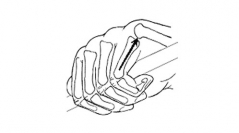

 Comptes Rendus Palevol
16 (5-6) - Pages 533-544
Comptes Rendus Palevol
16 (5-6) - Pages 533-544Reconstructing function from hominin fossils is complicated by disagreements over how to interpret primitively inherited, ape-like morphology. This has led to considerable research on aspects of skeletal morphology that may be sensitive to activity levels during life. We quantify trabecular bone morphology in three volumes of interest (dorsal, central, and palmar) in the third metacarpal heads of extant primates that differ in hand function: Pan troglodytes, Pongo pygmaeus, Papio anubis, and Homo sapiens. Results show that bone volume within third metacarpal heads generally matches expectations based on differences in function, providing quantitative support to previous studies. Pongo shows significantly low bone volume in the dorsal region of the metacarpal head. Humans show a similar pattern, as manipulative tasks mostly involve flexed and neutral metacarpo-phalangeal joint postures. In contrast, Pan and Papio have relatively high bone volume in dorsal and palmar regions, which are loaded during knuckle-walking/digitigrady and climbing, respectively. Regional variation in degree of anisotropy did not match predictions. Although trabecular morphology may improve behavioral inferences from fossils, more sophisticated quantitative strategies are needed to explore trabecular spatial distributions and their relationships to hand function.
Trabecular bone, BV/TV, Degree of anisotropy, Hand function, Bone volume